Read Reviews
The Best Football Goal Posts
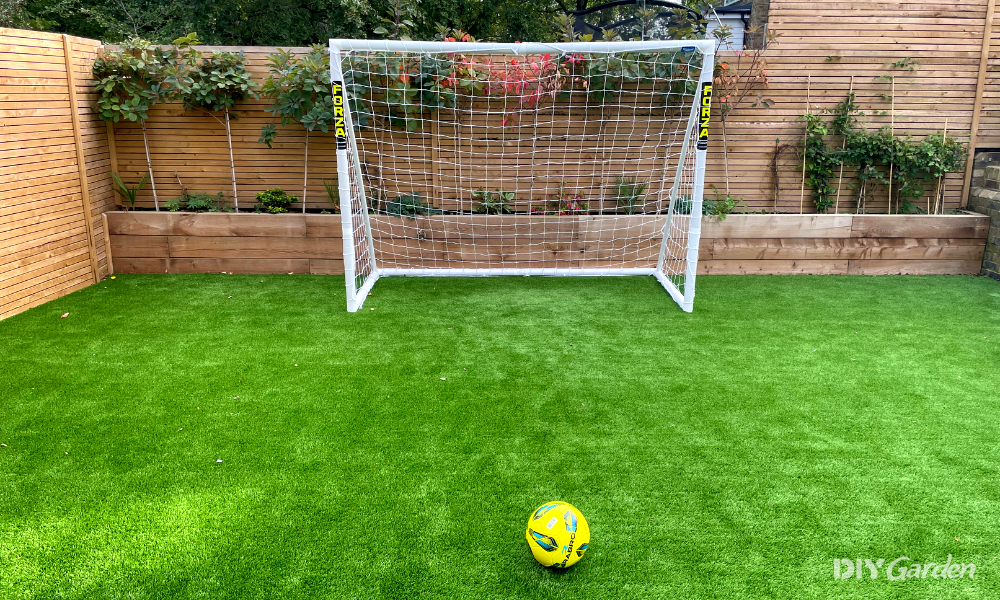
-
Best large football goal - FORZA Locking Football Goal [8ft x 6ft]
-
Best for smaller gardens - FORZA Football Goal [6ft x 4ft]
-
Best brand - SAMBA Locking Football Goal
-
Best goal with a metal frame - FORZA Steel42 Football Goal
-
Best frame design - Football Flick Ultimate All Weather uPVC Football Goal
-
Best for young kids - Dimples Excel Football Goal Pop Up
-
Best pop up goal - Happy Jump 6'x3' Football Goal Pop Up
-
Best portable football goal - QUICKPLAY Kickster Fun Goal 6x4’
-
Best for target practice - Kickmaster Quick Up Goal And Target Shot
-
Best for stopping the ball going over - QUICKPLAY Football Mega Net
Football Goal Post Reviews
1. FORZA Locking Football Goal [8ft x 6ft][ SAVE 18% ]
Best large football goal
- Easy to assemble with clear instructions
- Light and easy to move around your garden
- Durable frame that can take hard shots
- Well designed net clips that keep it attached
- Small white particles inside the posts, most likely from the manufacturing process
- Size
- 8ft x 6ft
- Material
- PVC
- Design
- 5
- Build Quality
- 5
- Durability
- 5
- Fun Factor
- 5
- Value for Money
- 5
If your kids are football mad like mine, then investing in a proper goal post for the garden is a must!
Having assembled, gifted, and played with the FORZA Locking Football Goal, I’ve got no hesitation recommending it as my top pick.
Let’s start with assembly. There’s always that slight pause and assessment when you open the box – is this going to be easy or a nightmare! Thankfully, these goals are really easy to put together, and the instructions are very clear to follow.
I purchased two of these goals for my garden, so we can have a little pitch. The first took 35 minutes to assemble, and the second time around it only took 22 minutes. That was just me on my own, without any help. And with the goal being 8ft x 6ft, it’s pretty big too!
All the part are well numbered, and the diagrams are clear, so you know exactly what goes where.
One thing I didn’t quite like was the some of the plastic had small white particles inside and I had to vacuum my living room after! I think this could be rectified with some kind of industrial vacuum/blower during the manufacturing process. But if you’re building the goals directly in your garden it isn’t really an issue.
Once the frame is up, you have to attach the net. You get 25 little clips that attach around the base, posts and crossbar. They’re rigid and designed in a clever way to stop the net coming lose.
Once errected, I dragged the goal out to my garden, which was nice and easy as it’s fairly light.
Next was the fun part, opening the curtains on my kids birthday to show him our new pitch! After many hours of smashing balls into the net I can safely say this is one of the best football goals our garden has ever seen! And trust me, we’ve been through quite a few of them as they’ve grown up!
Did you find this review helpful?
2. FORZA Football Goal [6ft x 4ft]
Best for smaller gardens
- Lightweight at just 14.6 kg - easy to move in and out of storage, or around the garden
- Easy to both put together and take apart thanks to the clear instructions
- 6 ft x 4 ft size is large enough for both children and adults to enjoy
- Robust and fully weatherproof - can be left outside in strong winds and rain
- Optional target sheet helps develop aim
- Although assembly is easy, fixing the net can be a little tricky if it gets tangled
- Size
- 6ft x 4ft
- Material
- PVC
- Design
- 5
- Build Quality
- 5
- Durability
- 5
- Fun Factor
- 5
- Value for Money
- 5
Suitable for young kids, up to teenagers, this 1.8 x 1.2 m (6 x 4 ft) Forza Football Goal is durable, good value for money and easy to transport.
Coming with a carry bag, football and optional target sheet included, this is a quality set with all the components needed to start enjoying a game of kick about in the garden straight away.
Made from durable, shatterproof 68 mm uPVC, these goal posts take around 30 minutes to put together. The poles lock into each other, instead of just sliding into place (as is the case with many cheaper models), to create a strong and stable frame. It’ll be able to withstand some hefty whacks from the kids as well as dad’s overenthusiastic crossbar smashes.
All of the materials are fully weatherproof as well, so there’s no need to take the goal down everyday after use. The net itself is UV treated, protecting it from degrading in sunlight.
Even though it’s not necessary to regularly take down the goal posts, doing so is extremely quick and easy. If you’d like the option of packing up the goal and taking it over to the grandparents’ house, this can be done with very limited hassle. Everything comes apart easily and can be transported neatly in the carry bag – a great option for keeping the kids (and adults?) entertained wherever you are.
There are two ground pegs included, to keep the goal secure, but it’s also easy simple enough to move the posts around when needed, to switch up their location in the garden.
Due to this goal’s size, you may find that children older than 10 years old start to get too big for it. Although they’ll still be able to enjoy using these posts, older children will fill a fair amount of the goal – at this point, they may benefit from a larger model.
Overall, this is one of the best children’s goal posts because of its stability, versatility and value for money. The fact that it’s so easy to put up and down means your kids can get a lot of use from it, even away from home, but it’s also strong and durable enough to be up all year round in the garden if you want.
Did you find this review helpful?
3. SAMBA Locking Football Goal
Best brand
- Very simple to assemble in around 30 minutes thanks to the clear instructions
- Lightweight enough to move around the garden when you want to mow the lawn
- Strong interlocking posts that withstand hard shots
- Clips used to hold net in place are good quality and strong
- Putting the clips on the net can be fiddly and take longer than setting up the frame
- Size
- 6ft x 4ft
- Material
- PVC
- Design
- 5
- Build Quality
- 5
- Durability
- 5
- Fun Factor
- 5
- Value for Money
- 4.5
A well-known name when it comes to goal posts, Samba’s Locking Football Goal is often used in schools and clubs so you know this is a good piece of equipment.
Suitable for young children up to teenagers, this 1.8 x 1.2 m (6 x 4 ft) goal comes with the goal posts, a strong rot-proof net, net clips, and ground anchors to keep the goal firmly in place even if the keeper bashes into it.
It’s made from robust uPVC, with posts that measure 68 mm in diameter to keep them secure even if there are a lot of high-impact shots making their way into goal. The locking system also keeps all of the poles securely in place, meaning no parts can be jolted from position, and it won’t come apart if you simply want to move the goal posts to another position.
This locking system makes assembling and dissembling the goal very easy as well. It takes around 30 minutes to get the goal set up, and when it’s time to take the goal posts down, you press the locking button to take it apart.
As mentioned, this goal will probably start to get too small for children once they reach 10/11 years old as they will fill too much of the space. However, it’s an excellent option for kids under 10.
All things considered, these are some of the best football goal posts in terms of quality. From the stability of their construction, to the reputation of Samba as a company, these goal posts offer a high standard, durable option.
Did you find this review helpful?
4. FORZA Steel42 Football Goal
Best goal with a metal frame
- Good net tension so the ball bounces back out towards you
- Strong frame and net withstands powerful shots
- Not prone to rust, even after several years outside
- Quick to assemble in around 40 minutes with no tools required
- Larger size makes it suitable for teenagers
- A more premium (and therefore more expensive) model than many others on the market
- Discoloration can occur in the metal after a few months of it being outside
- Size
- 8ft x 6ft
- Material
- Metal
- Design
- 5
- Build Quality
- 5
- Durability
- 5
- Fun Factor
- 4.5
- Value for Money
- 4
Made from 42 mm galvanized steel, the FORZA Steel42 Football Goals are extremely high quality, premium goal posts.
Available in a range of sizes, the 2.4 x 1.8 m (8 x 6 ft) goals are perfect if you have slightly older children, or want to buy something that kids will continue to grow into. As you can imagine, with these goals being 1.8 m (6 ft) high, they’re suitable for the majority of teenagers.
As with all Forza goals, the Steel42 has a built-in locking system. This means that the tough steel bars fit tighter than standard goalposts, creating a locked structure where the poles aren’t in danger of wiggling out of place.
The crossbar is also extremely strong, which is the component which often starts to badly ‘dip’ after months of tension and pressure on standard goal posts. Customers report that this premium goal holds its shape much better than plastic goal posts, and is in another league (!) in terms of stability compared to cheaper models.
As you would expect, these goal posts are extremely robust and can be left outside in all weather. Although the galvanised steel may suffer some discoloration, it doesn’t rust – even after several years. As with all the best football goal posts, the Steel 42 comes with bungee cord net attachments and anchor pegs to keep it safely in place.
These are the best football goal posts to buy if you want premium, metal posts that are large enough for older children. The posts are extremely robust and sturdy and will easily provide several years of use.
Did you find this review helpful?
5. Football Flick Ultimate All Weather uPVC Football Goal
Best frame design
- Sturdy and strong frame even when the ball is hit hard into the net
- Easy to assemble in around 15 minutes thanks to the simple instructions
- UV treated frame so shouldn’t weaken over time
- Less clips for net makes it less fiddly to assemble compared to some other goals
- Can be secured to the ground using the included ground pegs
- Net tension isn’t particularly strong - may become more loose over time
- Over time the crossbar may start to flex
- Size
- 6ft x 4ft
- Material
- PVC
- Design
- 5
- Build Quality
- 5
- Durability
- 5
- Fun Factor
- 5
- Value for Money
- 4.5
The Football Flick Urban Football Goal is durable and lightweight, designed for any children who might take an interest in scoring a few penalties against mum and dad, or having a game of kick about with their mates.
It measures 1.8 x 1.2 m (6 x 4 ft) so is the perfect size for younger children up to around 10 years old. However, there are also other sizes available, with the largest being 3.7 x 1.8 m (12 x 6 ft). This set comes with the goal, net clips and ground pegs included.
Simple to build in just 15 minutes, these are some of the best football goal posts for ease of assembly. There are less clips to connect the net to the crossbar, which is the part that can be particularly fiddly with other goals. This does mean that the net is unlikely to have the same level of tension of some nets, like the Forza Steel42, but it’ll be less fuss to put together.
The frame has a rigid locking system and is simple to slot together. It’s designed for use in all weathers and is UV treated, sturdy and robust. Although it can certainly withstand a powerful kick or two, it’s worth noting that the crossbar may start to flex slightly over time – a typical scenario for many goal post frames. The net has also been UV treated to stop it from degrading in the sun.
As mentioned, this goal comes with ground pegs so it can be secured into the lawn. It’s also very lightweight. At just under 10 kg, this goal can be easily picked up and moved to a different spot in the garden, clearing space so you can mow the lawn.
Did you find this review helpful?
6. Dimples Excel Football Goal Pop Up[ SAVE 9% ]
Best for young kids
- Simple enough for children to assemble by themselves
- A good size for small gardens, measuring 1.2 x 0.9 m (4 x 3 ft)
- Smaller size helps children to practice their accuracy
- Takes up very little storage space
- Carry bag comes included to help transport the goals
- Not the sturdiest in strong winds or when balls are kicked very powerfully
- Seams aren’t very strong and may weaken over time
- Size
- 4ft x 3ft
- Material
- Fibreglass
- Design
- 5
- Build Quality
- 4
- Durability
- 4
- Fun Factor
- 4.5
- Value for Money
- 5
A small, simple pop up goal, the Dimples Excel Football Goal Pop Up can be easily assembled in minutes. It gives kids the opportunity to have a goal in the garden when there isn’t enough space for permanent goal posts, and can also be easily transported to the park or beach.
Although it only measures 1.2 x 0.9 m (4 x 3 ft), it doesn’t need to be used exclusively by younger children; older kids may also enjoy being able to easily carry this compact goal with them to play with their friends. Otherwise, it’s an appropriate size for children around three – seven years old.
For younger kids, it’s a good size and is great for practising accuracy. Whilst bigger nets can take up too much space in small gardens, this net is a great size for smaller outdoor spaces. If you’d prefer a larger size however, it’s also available in 1.8 x 0.9 m (6 x 3 ft), 2.7 x 1.5 m (9 x 5 ft) and 3.7 x 1.8 m (12 x 6 ft).
This goal is incredibly easy to set up, even for kids to do on their own. There’s no frame to put together, and it simply pops up straight out of the bag. When you want to put it away, it’s easy to collapse the goal down into the included carry bag. It’s lightweight, and the carry bag comes with a shoulder strap so it can be taken to the beach, park or a friend’s house.
For this reason, it’s one of the best football goal posts if you’re after something small, compact and portable that can easily be carried – even by young children.
It may lack the full durability of solid goal posts, but as pop-up goals go, this one is still fairly robust. The fibreglass poles are good quality and weather resistant, and there are four ground pegs included for additional stability.
Although the fabric crossbar doesn’t provide the same rebound excitement as a metal or plastic frame, the ease of use, assembly and portability makes these goal posts a great choice for any aspiring Premier League players!
Did you find this review helpful?
7. Happy Jump 6'x3' Football Goal Pop Up
Best pop up goal
- Relatively easy to set up in just a few minutes thanks to the simple instructions
- Comes with a bag for easy storage when not in use
- Relatively robust even in strong winds
- Net not particularly durable, especially if regularly subjected to powerful shots
- Hook pegs don't stay in the ground particularly well so will need to be continuously put back in place
- Size
- 6ft x 3ft
- Material
- Fibreglass
- Design
- 4.5
- Build Quality
- 4
- Durability
- 4
- Fun Factor
- 4.5
- Value for Money
- 5
The Happy Jump Football Goal Pop Up is perfect for children aged 5 – 10 years old. It’s a medium-sized goal, measuring 1.8 x 0.9 cm (6 x 3 ft), and will be great for anything from penalty shoot outs, to 5-aside games with the nextdoor neighbours.
The frame is made using quality Dacron material and the fibreglass poles have been upgraded from the standard 6 mm diameter to 8 mm. In addition, the pole sleeves are made from 400D Oxford fabric, known for its weather resistance, so there are a lot of quality components to this goal. Each pole is connected using an 8 mm thick bungee cord which gives it even greater durability.
Designed for portability, this goal is easy to both put up and take down. It simply pops up, and can be folded back down into the waterproof carry bag if needed. This allows it to be transported on camping trips or to the beach or park. It’s lightweight, meaning that even the kids can move it around if necessary.
Galvanised steel stakes come included, to secure it to the ground. These stakes can also be used to secure the posts during storms or strong winds, allowing it to be left outside in all weathers.
Overall, these are some of the best football goal posts if you want a 1.8 m (6 ft) pop-up goal that’s made of good quality materials and offers value for money.
Did you find this review helpful?
8. QUICKPLAY Kickster Fun Goal 6x4’[ SAVE 14% ]
Best portable football goal
- Net is strong and withstands powerful kicks
- Metal pegs hold the goal down and are good quality
- Very portable and comes with a bag so can be taken anywhere
- Can be set up in minutes thanks to the pop up design
- Far less bulky than goals with plastic frames - much easier to store when not in use
- No crossbar or frame means you won’t get rebounds as you would in a real football match
- Size
- 6ft x 4ft
- Material
- Alloy Steel, Fibreglass
- Design
- 4.5
- Build Quality
- 4
- Durability
- 4
- Fun Factor
- 4.5
- Value for Money
- 4
The Quickly Kickster Portable Goal is a highly practical pop-up goal. If you’re after something that is extremely easy to transport, these are some of the best football goal posts to choose. There’s none of the bulk of traditional football goals, making both storage and portability a whole lot easier.
This goal measures 1.8 x 1.2 m (6 x 4 ft) which makes it a good size for children up to approximately 10 years old. Although it may not be quite as robust as the solid-frame goals featured on this list, it’s a really excellent option if you’d prefer to have temporary posts in the garden that can be speedily put up and taken down.
Instead of having the traditional plastic/metal frame, this goal is supported by a much smaller plastic structure. It holds the frame of the goal in place using tension, and bounces back into shape if it is knocked. Even though it doesn’t have a solid frame, it is still strong enough to withstand the usual levels of enthusiastic goal scoring.
The rot-proof net is also set up with extra bounce. The net has a unique shock absorbing bungee system which gives it greater durability. Plus, trying to volley the rebounds back into the goal is a game that can be played by just one child alone so this goal provides plenty of entertainment.
Naturally, this goal also benefits from being incredibly easy to set up. The pre-attached pole system means it pops up and packs away in just a few minutes, and it’s easy enough to set up at the beach or park at the weekend. There are pegs included to pin it into place.
Also it’s extremely lightweight, weighing just 3.5 kg, so there are no problems with moving it to a different spot whenever the grass needs a rest.
Although this might not be as robust as solid goal posts, it is still sufficiently stable to provide children with plenty of football-based entertainment. The main benefit, of course, is how extremely easy it is to put up and take down, which will be a real advantage in certain gardens.
Did you find this review helpful?
9. Kickmaster Quick Up Goal And Target Shot[ SAVE 16% ]
Best for target practice
- Lots of fun and also develops football skills - helps to improve accuracy
- Double sided - open net for free shots/penalties with the other perfect for target practice
- Metal ground pegs help to secure it in place
- Can be put up and packed away very easily
- Comes with a carry bag for easy transportation and storage
- Relatively lightweight so unlikely to be secure in strong winds
- Kicking balls with too much power may damage the net over time
- Size
- 3.5ft x 2.5ft
- Material
- Polyester
- Design
- 5
- Build Quality
- 3.5
- Durability
- 3.5
- Fun Factor
- 5
- Value for Money
- 5
For footballers looking to perfect their shooting accuracy, the Kickmaster Quick Up Goal and Target Shot is one of the best football goal posts around.
This goal can be used in two ways; either as a standard net, or it can be flipped over and used for target practice. Each section is labelled with the number of points that each shot will receive – 500 for a top corner penalty! This is a great way to get kids (and parents!) enjoying high-intensity penalty shoot-out competitions with friends and family.
This dual-purpose goal adds a whole new dimension to your football practice. It’s also one of the smallest goals featured here, measuring 1.06 x 0.76 m which makes it ideal for smaller gardens and really testing accuracy. It pops up instantly and comes with anchor pegs included so that it can be secured to the ground. To put away, it simply folds down and can be put back in the included carry bag, making it very easy to take to the beach, park or friend’s houses!
Although it’s not the most weather-resistant goal on the market, it’s so easy to put up and take down that this doesn’t really matter – you can pack it away in minutes if it starts to rain. It’s also worth noting that very powerful shots may cause damage to the net over time.
If you’re looking for a small goal that’ll offer hours of enjoyment and specifically help improve accuracy, this Kickmaster goal is a great option to consider.
Did you find this review helpful?
10. QUICKPLAY Football Mega Net
Best for stopping the ball going over
- A good option if you regularly lose balls - surrounding net helps reduce lost footballs
- Taller than many fences so can stop footballs going into neighbour’s garden
- Easy to set up in just a couple of minutes
- Detachable goal area offers target practise
- Easy to store away in included carry bag with a shoulder strap
- Measures 2.4 x 1.2 m (8 x 6 ft) so you need a fair amount of space in your garden for this net
- Goal target attaches to net, so there is no actual goal space for the ball to go into - it rebounds back
- Size
- 8ft x 6ft
- Material
- Fibreglass
- Design
- 4
- Build Quality
- 4
- Durability
- 4
- Fun Factor
- 4
- Value for Money
- 4
If your kids are constantly kicking balls over into the next-door neighbour’s garden, the Quickplay Football Mega Net combines a net barrier with a goal to stop balls going over the fence. Designed to help fine-tune shooting skills, whilst also reducing the chance of a lost football, this net contains both a goal target measuring 1.2 x 1.2 m (4 x 4 ft), as well as a large boundary net measuring 2.4 x 1.8 m (8 x 6 ft).
Whilst this net won’t stop every misfire, it should still prevent a lot of shots from hurtling over the fence. The 1.2 x 1.2 m goal guide attaches to the net using Velcro, offering a specific target for shooting practice as well as a number of other games. Given the tension of the net, the ball will simply bounce back towards you, making it useful for one player games as well.
Due to the style of this goal net, it could also be used to protect cars and windows from any slightly wayward shots! As a result, this is one of the best football goal posts for keeping balls within the boundaries of your own garden, and it offers a little more security when the kids play compared to regular posts.
This net takes seconds to set up and it’s even quicker to pack away. The pre-attached pole system means there’s no threading poles through the fabric, and there’s no need for an instruction manual. It packs down into its own slimline carry bag with a handy shoulder strap. If you want, you’ll be able to take this goal on camping trips, to the beach or park – but it is slightly larger than ‘standard’ portable goals.
With metal pins that secure it to the ground, this football goal remains in place even under the pressure of more powerful shots. It should also be able to withstand the odd windy day. However, it’s also incredibly easy to pack down and store, so this is easily done when it’s not in use in order to keep it protected.
Did you find this review helpful?
Product Tester
Compare Product Features
Use the dropdown to sort the table by the feature you want to see.
FORZA Locking Football Goal [8ft x 6ft]
- 5
- 8ft x 6ft
- PVC
FORZA Football Goal [6ft x 4ft]
- 5
- 6ft x 4ft
- PVC
SAMBA Locking Football Goal
- 4.9
- 6ft x 4ft
- PVC
FORZA Steel42 Football Goal
- 4.7
- 8ft x 6ft
- Metal
Football Flick Ultimate All Weather uPVC Football Goal
- 4.9
- 6ft x 4ft
- PVC
Dimples Excel Football Goal Pop Up
- 4.5
- 4ft x 3ft
- Fibreglass
Happy Jump 6'x3' Football Goal Pop Up
- 4.4
- 6ft x 3ft
- Fibreglass
QUICKPLAY Kickster Fun Goal 6x4’
- 4.2
- 6ft x 4ft
- Alloy Steel, Fibreglass
Kickmaster Quick Up Goal And Target Shot
- 4.4
- 3.5ft x 2.5ft
- Polyester
QUICKPLAY Football Mega Net
- 4
- 8ft x 6ft
- Fibreglass
How We Chose Our Recommendations
When selecting football goals for your garden, we keep a keen eye on several factors when selecting our product recommendations:
- Size & Space: The size of your garden matters. We consider goals that fit comfortably within your available space while providing enough room for enjoyable play.
- Durability: Garden football goals need to withstand all sorts of player abilities and weather conditions. We look for goals constructed from sturdy materials like steel or weather-resistant PVC to ensure they can handle the elements.
- Ease of Assembly: No one wants to spend hours deciphering complicated instructions. We favor goals that are easy to assemble and disassemble.
- Safety: Safety is paramount, especially when it comes to children. We prioritize goals that come with sturdy netting, secure anchors, and rounded edges to minimize the risk of accidents.
- Portability: The ability to move your goal around the garden is a significant advantage. Goals with lightweight frames are appreciated for their convenience.
- Net Quality: A good goal needs a good net. We consider goals with high-quality, durable nets that can withstand countless shots without fraying or tearing.
- Price & Value: While we always seek value for your investment, we also ensure that the price reflects the quality and features of the goal.
How to Choose The Best Football Goal Posts
Having football goal posts in the garden can provide hours of fun for your family.
There are different designs available, depending on what you’re after. Goal posts with targets can help improve precision, whilst larger nets stop footballs going into the neighbour’s garden. Alternatively, pop-up goals can be a great option for family holidays or smaller gardens.
The following guide will give you a better idea of what to look for when choosing football goal posts for the garden.
Materials
When it comes to material you should think about whether you need to leave football goal posts outside all year round.
If so, aluminium posts are very popular as they’re rustproof and take the hassle out of putting them up and down if it rains, plus they are lightweight enough to move single handed.
If you’re looking to splash out on professional standard goal posts then look at steel which is the gold standard and much stronger than aluminium. I wouldn’t recommend steel football goal posts for smaller children though, as they can hurt themselves bumping into the posts.
UPVC is another popular goalpost material. It’s weatherproof and can take a lot of force, but it’s simple to pack away. Many upvc goal posts have locking systems to keep them firmly in place.
At the cheaper end of the scale, there are all-synthetic fibre goals which are quick to pop and up and down. They don’t last in all weathers but fold up easily so you can take them places or store them in the shed.
Nets are often overlooked when it comes to choosing the best goal post for the garden, but netting takes just as much abuse as posts, especially if your kid is a good shot.
The thinnest netting grade is 1.6mm. It’s cheap and won’t last long, a better option is netting that measures 5mm – this is what they use in professional matches. It’s more expensive but it’ll last you longer.
Polypropylene is a modern and popular material for goal netting. It’s a type of plastic that’s much more hardwearing than fibre or twine nets. If you can find HDPE – that’s high-density polyethylene, it’ll last even longer.
Whatever you choose, pull nets clear of the ground when you’re not using them to prevent wildlife from getting trapped.
Size
Goalposts are available in different sizes to match the age of your children. The Football Association has regulations if you want to use them!
- For kids under seven – an 8×4 foot goal
- For kids aged under twelve – 16 x 7-foot goal
- Full-sized goalposts are for kids aged over 15
Of course, you can ignore this advice as it’s only regulation for professional games, and after-school clubs, but you’ll find the sizes make sense compared to your kid’s height.
However, it does depend on the size of our garden. Nowadays gardens tend to be compact, so getting goal posts in there might be tricky.
Choose kids football goal posts that are big enough to have fun, but don’t ruin your outside space. A 6-8 x 4 foot goal is big enough for primary school kids to enjoy.
One other aspect to be aware of is the space inside the goal.
If you have an aspiring goal-keeper they will need room inside the net to make a save. If grandad is stuck as goalie it doesn’t matter so much.
Weatherproofing
Are you planning to leave the goal posts outside in all weathers?
If so, choose aluminium, steel or upvc posts with a polyethylene net.
This will ensure the goalposts don’t rust or rot in our wet and damp weather, or get brittle in the sunlight and snap. If you choose these durable materials you won’t need to treat the goalposts with anything.
If you’re intending to bring them indoors, you can choose any material you like but I’d recommend you choose something that’s easy to take apart, such as a upvc locking system goal – which leads us nicely to…
Ease of Construction
If you’re one of those people that develops ‘the red mist of rage’ over half-cooked instructions choose something simple like a pre-set locking system or fold away goal posts.
Here are the options and their level of construction difficulty.
- Folding portable goals – the easiest and cheapest option. They fold out and fold down again. All you have to do is fit the ground anchoring pegs.
- Locking goals – these are already partially fitted and you just have to slot the bars into place so they seal and become durable. The Samba recommendation above has a button that unlocks the frame. They are portable and lightweight enough to take places.
- Lightweight free standing – you need to fit these together, but once in place they can stay put for years. This type of goalpost can be anchored with ground pegs.
- Steel free standing – large steel goals need construction and must be securely anchored. If you don’t plan to move them, the feet can be concreted into place.
If you choose a well-known brand, they will have a construction video on the home website for you to follow.
Difficult instructions usually come with cheap imported goals using Google translate. Forza and Samba have excellent customer service teams that’ll talk you through construction over the phone if you get stuck.
Football Goal Post FAQs
If you’re hoping to be scouted for a Premier League team in the near future, it’s worth practising your penalties in the right size goal! Premier League goals measure an impressive 24ft x 8ft.
Footballs are available in a range of sizes. For kids aged between 6 and 9, a size 3 football is best. Between 10 and 14 should use a size 4, and 14+ should use a size 5 football. Size 2 footballs are suitable for kids under 5 years of age.
If you’re wanting to practice your penalties Harry Kane-style, you’re going to need to ensure you’re taking them from the right spot! In professional football, the penalty spot is 12 yards (11m) from the goal line. In your own garden, the spot can be as close to the goal as you like – we won’t tell!
![best football goal post FORZA Locking Football Goal [8ft x 6ft]](https://cdn.diygarden.co.uk/wp-content/uploads/2023/10/best-football-goal-post-forza-locking-football-goal-8ft-x-6ft-1696498686.jpeg?class=opt)
![best football goal post FORZA Football Goal [6ft x 4ft]](https://cdn.diygarden.co.uk/wp-content/uploads/2023/01/best-football-goal-post-forza-football-goal-6ft-x-4ft-1674652383.jpeg?class=opt)
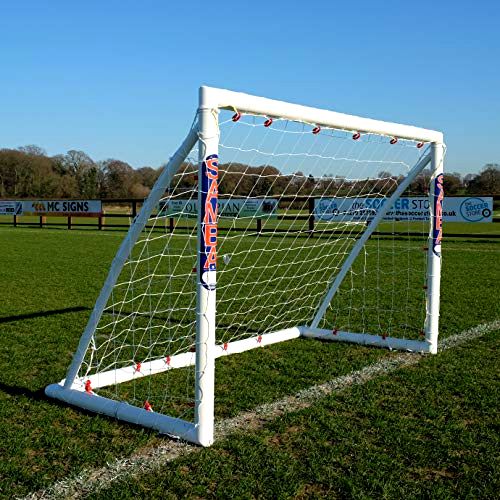
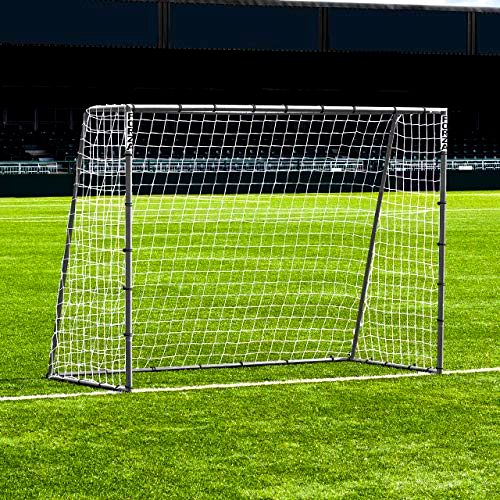
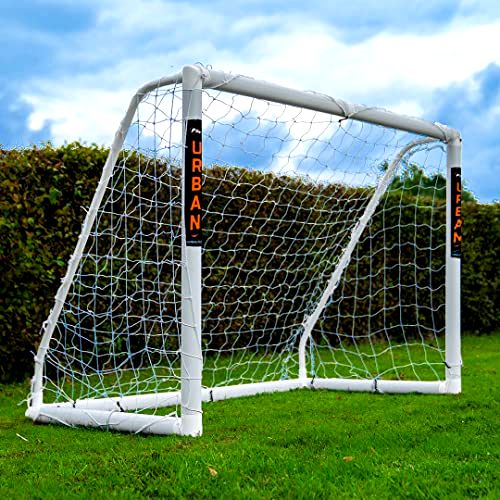
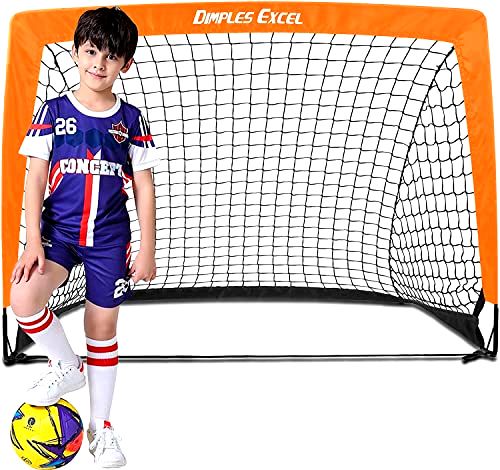
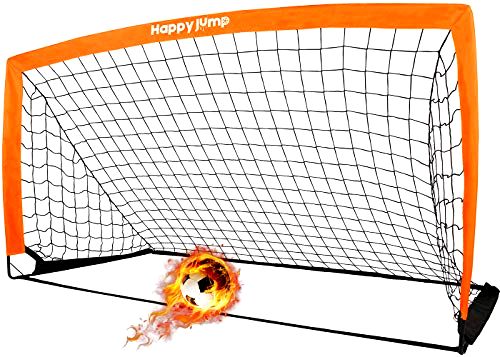
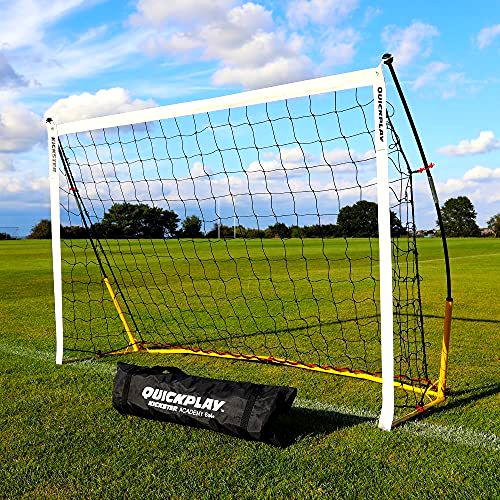
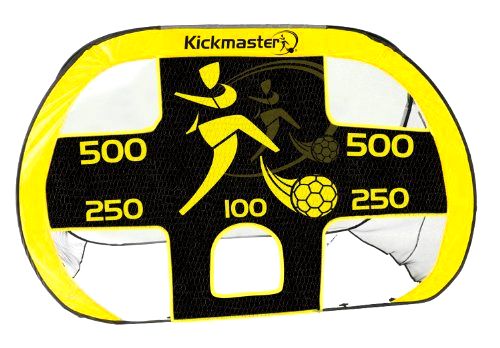
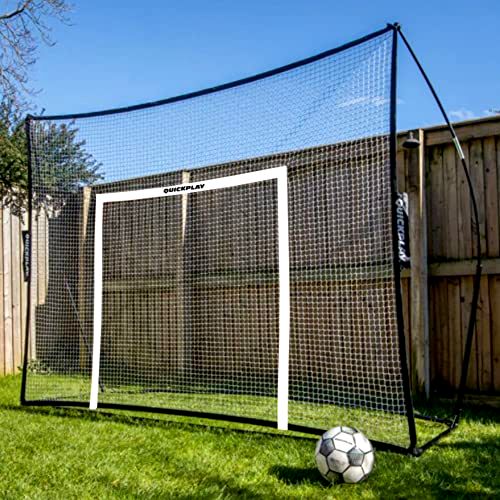
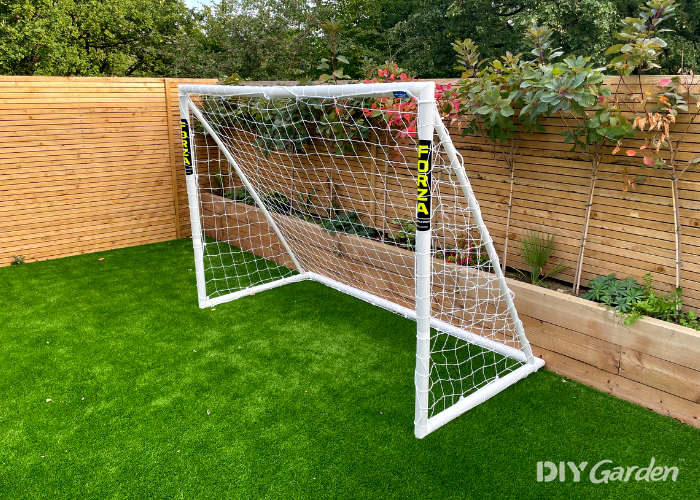
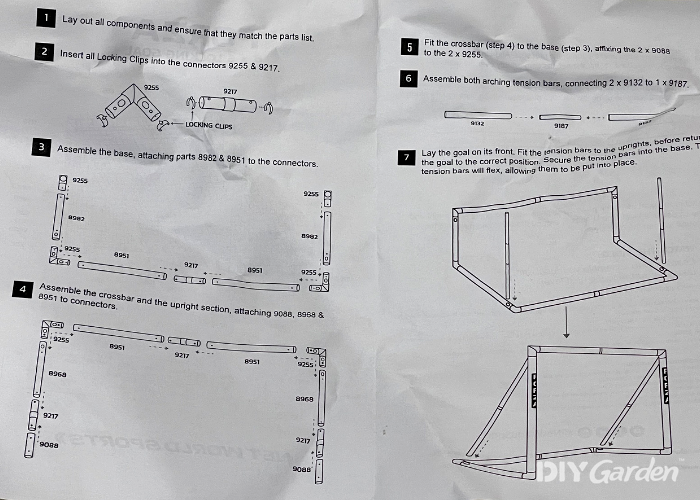
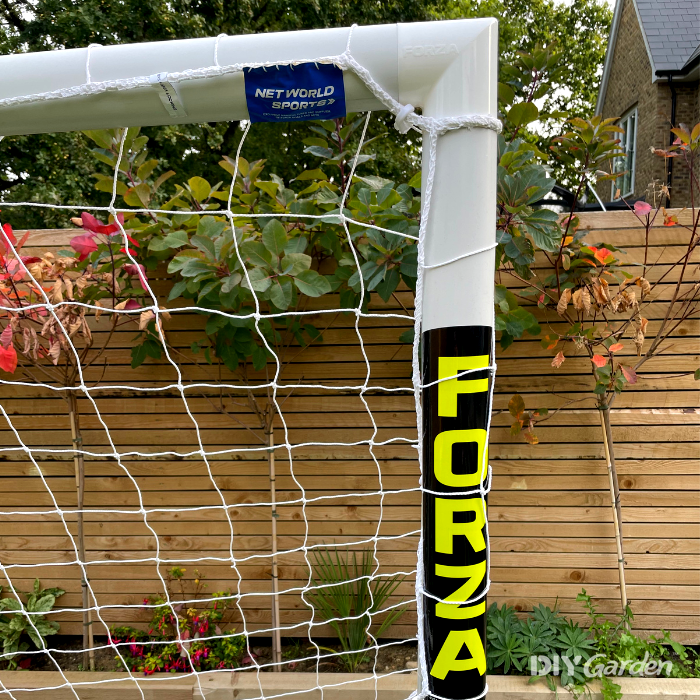
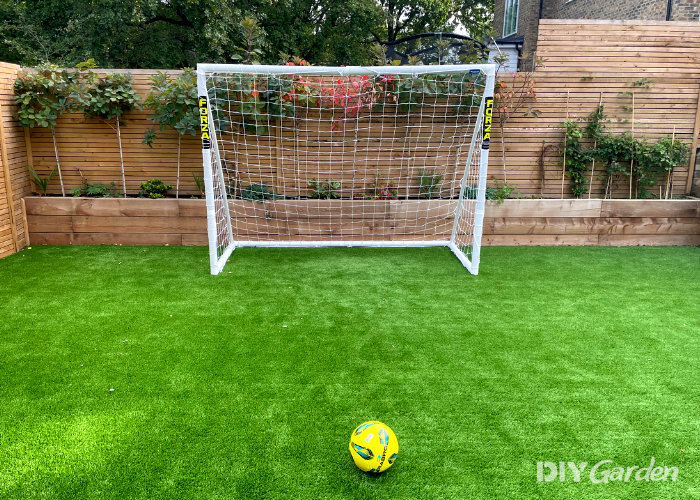

Share